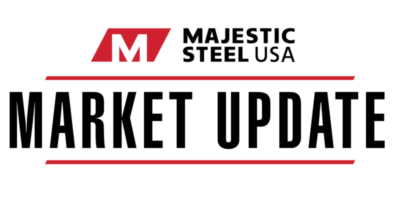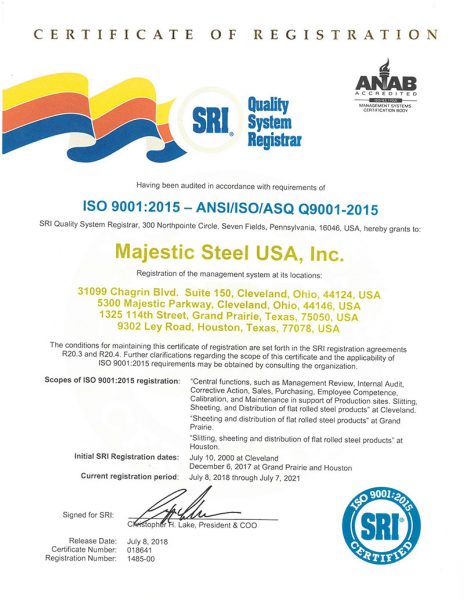Market Update | May 17, 2023
INDUSTRIAL PRODUCTION INCREASED IN APRIL
After holding flat for the previous two months, the Industrial Production Index increased to 103.0 in April, up from 102.5 previously. In addition, the Manufacturing component increased 1.0% to 99.8, boosted by gains in motor vehicle output. The boost in auto production helped to overcome the decline in miscellaneous manufacturing. Overall capacity utilization increased to 79.7%, right at the fifty-year average.
Input Costs
Zinc pricing moved lower this week after a slight increase last week.
-
-
Zinc pricing came in at $1.13/lb this week, down from last week and at its lowest level in over a year.
-
After the run up over the previous three months, spot iron ore pricing has remained steady over the past couple of weeks.
-
- Spot iron ore pricing is currently at $181.40 /mt, up from last week, virtually flat from last month, but up 7.0% over the last 90 days.
Decreased coking coal demand from buyers in India has pushed pricing lower.
-
- Coking coal pricing currently sits at $234/mt, down 4.9% from last week and down 7.7% from a month ago.
-
- Coking coal pricing is still down 40% from the recent peak seen in mid-February.
Supply
U.S. raw steel production rebounded last week, climbing to its highest weekly output since Labor Day.
-
- U.S. steelmakers produced 1.725 million tons at an 76.7% utilization rate: topping 76% for the third straight week.
- The current YTD utilization rate is at 74.9%, down 4.0% compared to the same time last year.
Preliminary April import licenses, (8 days), showed total carbon steel imports are up 20.5% from the same time in April and up 4.8% from the same pace in May 2022.
-
- Coated import licenses are down from April climbing 6.0% through the first eight days.
DEMAND
Business activity in the manufacturing sector, in the New York region, increased for the first time since November.
-
-
The Empire Manufacturing Index came in at 10.8 in April, up over 30 points from the -24.6 reading in March.
-
Both the new order and shipments components increased sharply in April, climbing to 25.1 and 23.9, respectively.
- While the unfilled orders and delivery time components were flat, inventories increased slightly after declining in March.
- Looking forward, business expectations over the next six months increased slightly, climbing to 6.6.
- The capital spending component increased to 16.5, up 3.0 points from March.
-
Industrial production increased in April after holding flat for the previous two months.
-
-
The Industrial Production Index came in at 103.0 in April, up from 102.5 previously.
-
The index was up slightly from 102.8 in April last year.
-
The Manufacturing component increased 1.0% to 99.8, boosted by gains in motor vehicle output.
- The boost in auto production helped to overcome the decline in miscellaneous manufacturing.
- Overall capacity utilization increased to 79.7%, right at the fifty-year average.
- Utilization from the manufacturing sector increased 0.7% to 78.3%, slightly above the long-run average.
-
Confidence among U.S. homebuilders improved in May climbing for the fifth consecutive month.
-
-
The May HMI came in at 50, up from 45 in April and out of negative territory for the first time since July.
- Despite the increase, the current HMI remains well below year ago levels.
- Any reading above 50 indicates positive optimism, while any reading below 50 denotes negative sentiment.
- Both the Present Situation and Next Six Months component increased sharply in May, climbing to 56 and 57, respectively.
- The Traffic component saw slight improvement but remained well into contraction.
- The lack of existing inventory continues to help boost builder sentiment despite higher rates and increased building material costs.
-
ECONOMIC
The Cass Information Systems, Linehaul Index continued to slide in April, now down for the eleventh consecutive month.
-
-
The April Linehaul Index came in at 146.6, down slightly from March and down 12.1% from 167.1 in April 2022.
-
This is the fourth consecutive month in which the index has declined on a year-over-year basis.
-
The Linehaul Index, which measures per-mile truckload pricing, excluding fuel and accessories.
- As a broad market indicator for truckloads, the index includes both spot and contract freight.
- With spot rates down sharply, the larger contract market is continuing to adjust lower as well.
-
This material, information and analyses (the “Content”) may include certain statements, estimates and projections prepared with respect to, among other things, historical data and anticipated performance. Content may reflect various assumptions by Majestic Steel USA, Inc. concerning anticipated results that are inherently subject to significant economic, competitive and other uncertainties and contingencies and have been included for illustrative purposes. Content is provided AS-IS.

